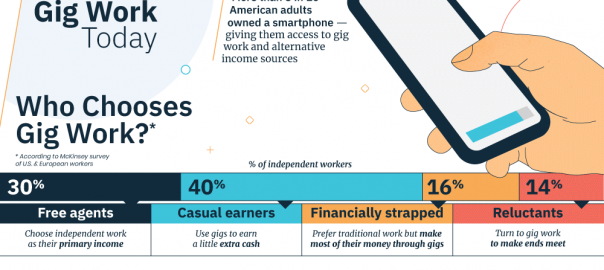The gig economy is at its peak with no plans of slowing down. By 2021, gig workers – freelance, independent, and contract workers – will outnumber traditional employees. Contrary to popular belief, gig work has been available for over 100 years, although today’s gig economy has taken a taken direction. The future of the United States gig economy has proven to be powerful enough to impact legislature. By 2027, 60% of the workforce will be independent professionals, and companies will spend up to $ 6 billion on improving the rights of gig workers.
In 1915, jazz musicians conceptualized the term “gig” in reference to live performances. As the term stuck, a job market came with it; hence, the rise of temp agencies following the Great Depression. By 1995, 10% of Americans worked in alternative employment, considering themselves contractors, temporary agents, and/or on-call workers.
As the digital era surfaced, the gig economy created its own market within it. In 1996, Craig Newmark started Craigslist, initially beginning as an email newsletter “San Francisco Events.” As Craigslist built a larger following, the list grew beyond local events to include job and apartment listings. In 2005, Amazon began hiring gig workers to perform microtasks deemed too complex for AI: transcriptionists, surgery answering, etc.
The early 2000s were the years of “apps.” In 2008, Airbnb was created by roommates in attempts to make rent, and it became the first app in the sharing economy. By 2018, Airbnb was worth $ 38 billion. That same year, TaskRabbit was created to hire individuals to run errands and complete simple chores. In 2010, Uber was designed, and within 5-years, Uber drivers had accepted 1 billion rides.
Today, more than 1 in 3 workers have engaged in some form of gig work. Additionally, more than 8 in 10 American adults own a cell phone, providing them with access to gig work and alternative income sources. Although popular, the benefits and income for gig workers may not always be steady, or measure up to traditional work. Keep reading below for more insight on the benefits and complications of the gig economy.
![The History and Future of the Gig Economy [Infographic] The History and Future of the Gig Economy [Infographic]](https://www.onlinesalesguidetip.com/wp-content/uploads/2019/11/The-History-and-Future-of-the-Gig-Economy-Infographic-scaled.png)
Infographic Source: Gigworker
Digital & Social Articles on Business 2 Community
(80)









